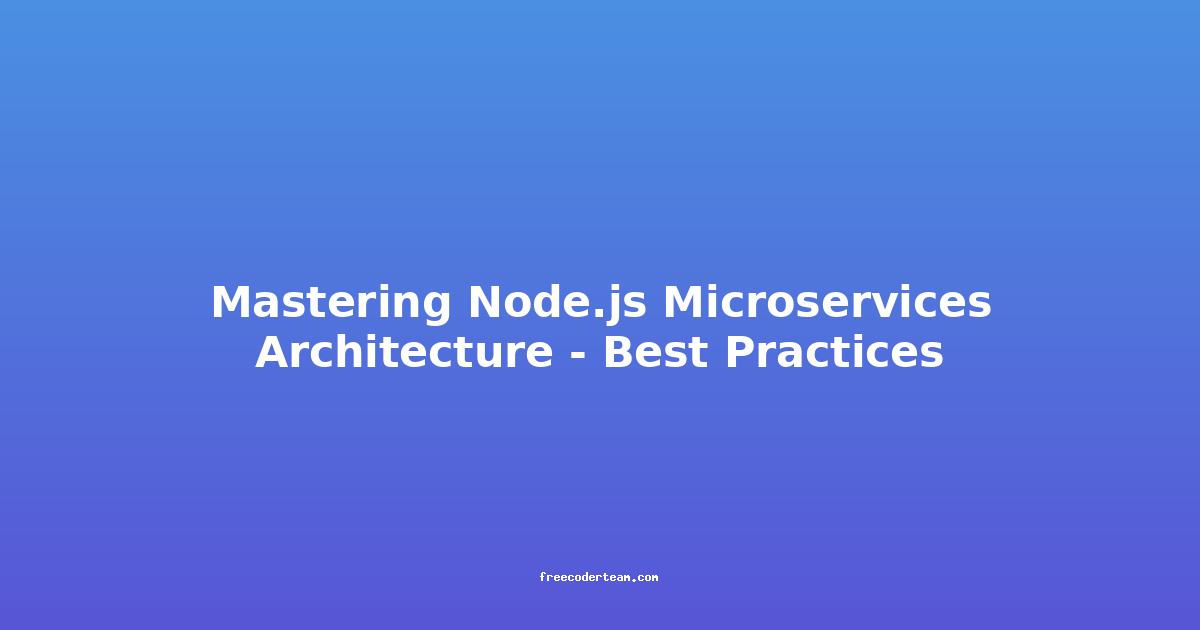Mastering Node.js Microservices Architecture: Best Practices
In the modern software landscape, microservices have become a cornerstone for building scalable, resilient, and maintainable applications. Node.js, with its event-driven, non-blocking I/O model, is an ideal choice for implementing microservices due to its performance and ease of use. In this blog post, we'll explore best practices for building microservices using Node.js, providing practical insights and actionable tips to help you master this powerful architecture.
Table of Contents
- Understanding Microservices Architecture
- Why Node.js for Microservices?
- Best Practices for Node.js Microservices
- 1. Define Clear Boundaries
- 2. Use Domain-Driven Design (DDD)
- 3. Embrace REST or gRPC
- 4. Centralize Configuration Management
- 5. Implement Circuit Breakers
- 6. Use Containerization with Docker
- 7. Monitor and Log Effectively
- 8. Use a Service Discovery Tool
- 9. Leverage API Gateways
- 10. Focus on Testability
- Practical Example: Building a Microservice in Node.js
- Conclusion
Understanding Microservices Architecture
Microservices architecture is an approach where an application is divided into small, independent services, each responsible for a specific business capability. These services communicate with each other through well-defined APIs, allowing for greater modularity, scalability, and independent deployment.
Key characteristics of microservices include:
- Decoupling: Services are independent and can be developed, deployed, and scaled separately.
- Technology Agnostic: Services can be built using different technologies, as long as they communicate via standardized APIs.
- Autonomy: Each service has its own database and is managed by a small team.
Why Node.js for Microservices?
Node.js is an excellent choice for microservices due to its:
- Asynchronous Nature: Node.js handles I/O operations asynchronously, making it highly efficient for handling multiple requests concurrently.
- Rich Ecosystem: A vast collection of npm packages provides tools for every stage of development, from database interactions to API management.
- Scalability: Node.js is well-suited for building fast and scalable web applications, making it ideal for microservices.
- Community Support: A large and active community ensures ample resources and support.
Best Practices for Node.js Microservices
1. Define Clear Boundaries
Each microservice should have a clear, well-defined responsibility. This helps avoid tight coupling between services and ensures that changes in one service do not cascade into others.
Example:
- A User Service handles user authentication and profile management.
- An Order Service manages order creation, tracking, and fulfillment.
2. Use Domain-Driven Design (DDD)
Domain-Driven Design (DDD) helps ensure that microservices align with the business domain. By modeling services around core business entities, you can create services that are both robust and maintainable.
Example: If your application involves e-commerce, you might have:
- Product Service: Handles product creation, inventory management, and pricing.
- Cart Service: Manages user carts and checkout processes.
3. Embrace REST or gRPC
Microservices communicate with each other via APIs. REST (Representational State Transfer) and gRPC are popular communication protocols.
- REST: Uses HTTP methods (GET, POST, PUT, DELETE) and is easy to implement and understand.
- gRPC: Uses Protocol Buffers for serialization and is more performant, especially for binary data.
Example: REST API in Node.js using Express
const express = require('express');
const app = express();
// Middleware to parse JSON
app.use(express.json());
// Example route for creating a user
app.post('/users', (req, res) => {
const { name, email } = req.body;
// Logic to create a user
res.status(201).json({ message: 'User created successfully' });
});
// Start the server
app.listen(3000, () => {
console.log('Server is running on port 3000');
});
4. Centralize Configuration Management
Each microservice should have a consistent way of managing configuration. Tools like Consul, HashiCorp Vault, or environment variables can be used to centralize configuration.
Example: Using Environment Variables
const config = {
port: process.env.PORT || 3000,
database: {
host: process.env.DB_HOST,
user: process.env.DB_USER,
password: process.env.DB_PASSWORD
}
};
5. Implement Circuit Breakers
To prevent cascading failures when a dependent service is unavailable, use circuit breakers. Libraries like Netflix Hystrix or resilience4j can help implement this pattern.
Example: Using Circuit Breaker with Axios
const axios = require('axios');
const circuitBreaker = require('opossum');
// Create a circuit breaker for API calls
const breaker = circuitBreaker(axios.get, {
timeout: 5000,
errorThresholdPercentage: 50,
hellDuration: 10000,
samplingDuration: 5000
});
// Use the circuit breaker
async function getCachedData() {
try {
const response = await breaker('https://api.example.com/data');
return response.data;
} catch (error) {
console.error('Circuit breaker tripped:', error);
return null;
}
}
6. Use Containerization with Docker
Docker simplifies the deployment and scaling of microservices. Each service can be packaged into its own Docker container, ensuring consistency across different environments.
Example: Dockerfile for a Node.js Microservice
# Use the official Node.js runtime as the base image
FROM node:16
# Set the working directory in the container
WORKDIR /app
# Copy package.json and package-lock.json before installing dependencies
COPY package*.json ./
# Install dependencies
RUN npm install
# Copy the rest of the application code into the container
COPY . .
# Expose the port the app runs on
EXPOSE 3000
# Define the command to run the Node.js app
CMD ["npm", "start"]
7. Monitor and Log Effectively
Monitoring and logging are critical for understanding the health and performance of your microservices. Tools like Prometheus, Grafana, ELK Stack (Elasticsearch, Logstash, Kibana), and Datadog can help.
Example: Using Winston for Logging
const winston = require('winston');
const logger = winston.createLogger({
level: 'info',
format: winston.format.combine(
winston.format.timestamp(),
winston.format.json()
),
transports: [
new winston.transports.Console(),
new winston.transports.File({ filename: 'combined.log' })
]
});
// Log an error
logger.error('An error occurred', { meta: 'example metadata' });
8. Use a Service Discovery Tool
In a microservices architecture, services need to discover each other dynamically. Tools like Consul, Eureka, or Kubernetes can help with service discovery.
Example: Using Consul for Service Discovery
- Start Consul:
consul agent -dev - Register a service:
const consul = require('consul')(); const options = { id: 'user-service', name: 'user-service', address: 'localhost', port: 3000, check: { http: 'http://localhost:3000/health', interval: '10s' } }; consul.agent.service.register(options, (err) => { if (err) { console.error('Error registering service:', err); } else { console.log('Service registered successfully'); } });
9. Leverage API Gateways
An API Gateway acts as a single entry point for clients, simplifying the client's interaction with multiple microservices. Tools like Kong, API Gateway in AWS, or NGINX can be used.
Example: Using NGINX as an API Gateway
http {
upstream user_service {
server localhost:3000;
}
server {
listen 80;
location /users {
proxy_pass http://user_service;
}
}
}
10. Focus on Testability
Microservices should be testable in isolation. Use unit tests, integration tests, and mocking to ensure that each service functions correctly.
Example: Unit Testing with Jest
const { createUser } = require('./userService');
test('createUser should return a user object', () => {
const user = createUser({ name: 'John Doe', email: 'john@example.com' });
expect(user).toHaveProperty('name', 'John Doe');
expect(user).toHaveProperty('email', 'john@example.com');
});
Practical Example: Building a Microservice in Node.js
Let's build a simple User Service using Node.js and Express.
Step 1: Set Up the Project
mkdir user-service
cd user-service
npm init -y
npm install express body-parser mongoose
Step 2: Create the Service
// app.js
const express = require('express');
const bodyParser = require('body-parser');
const mongoose = require('mongoose');
const app = express();
// Middleware
app.use(bodyParser.json());
// Connect to MongoDB
mongoose.connect('mongodb://localhost:27017/user-service', {
useNewUrlParser: true,
useUnifiedTopology: true
});
// Define User Schema
const userSchema = new mongoose.Schema({
name: String,
email: String
});
const User = mongoose.model('User', userSchema);
// Routes
app.post('/users', async (req, res) => {
try {
const user = new User(req.body);
await user.save();
res.status(201).json(user);
} catch (error) {
res.status(500).json({ error: 'Failed to create user' });
}
});
app.get('/users/:id', async (req, res) => {
try {
const user = await User.findById(req.params.id);
if (!user) {
return res.status(404).json({ error: 'User not found' });
}
res.json(user);
} catch (error) {
res.status(500).json({ error: 'Failed to fetch user' });
}
});
// Start the server
const PORT = process.env.PORT || 3000;
app.listen(PORT, () => {
console.log(`User Service is running on port ${PORT}`);
});
Step 3: Run the Service
node app.js
Conclusion
Mastering Node.js microservices architecture requires a combination of solid design principles, effective tooling, and best practices. By following the guidelines outlined in this blog post, you can build scalable, maintainable, and resilient microservices. Key takeaways include:
- Define clear boundaries for each service.
- Implement robust communication patterns like REST or gRPC.
- Use circuit breakers to handle failures gracefully.
- Containerize services for consistency across environments.
- Monitor and log to ensure service health.
With Node.js as your foundation, you can leverage its strengths to build high-performance microservices that meet the demands of modern applications. Happy coding!
Feel free to reach out if you have any questions or need further clarification on any of these topics! 🚀
Note: This post is for educational purposes and serves as a starting point for building microservices with Node.js. Always adapt these practices based on your specific project requirements.




